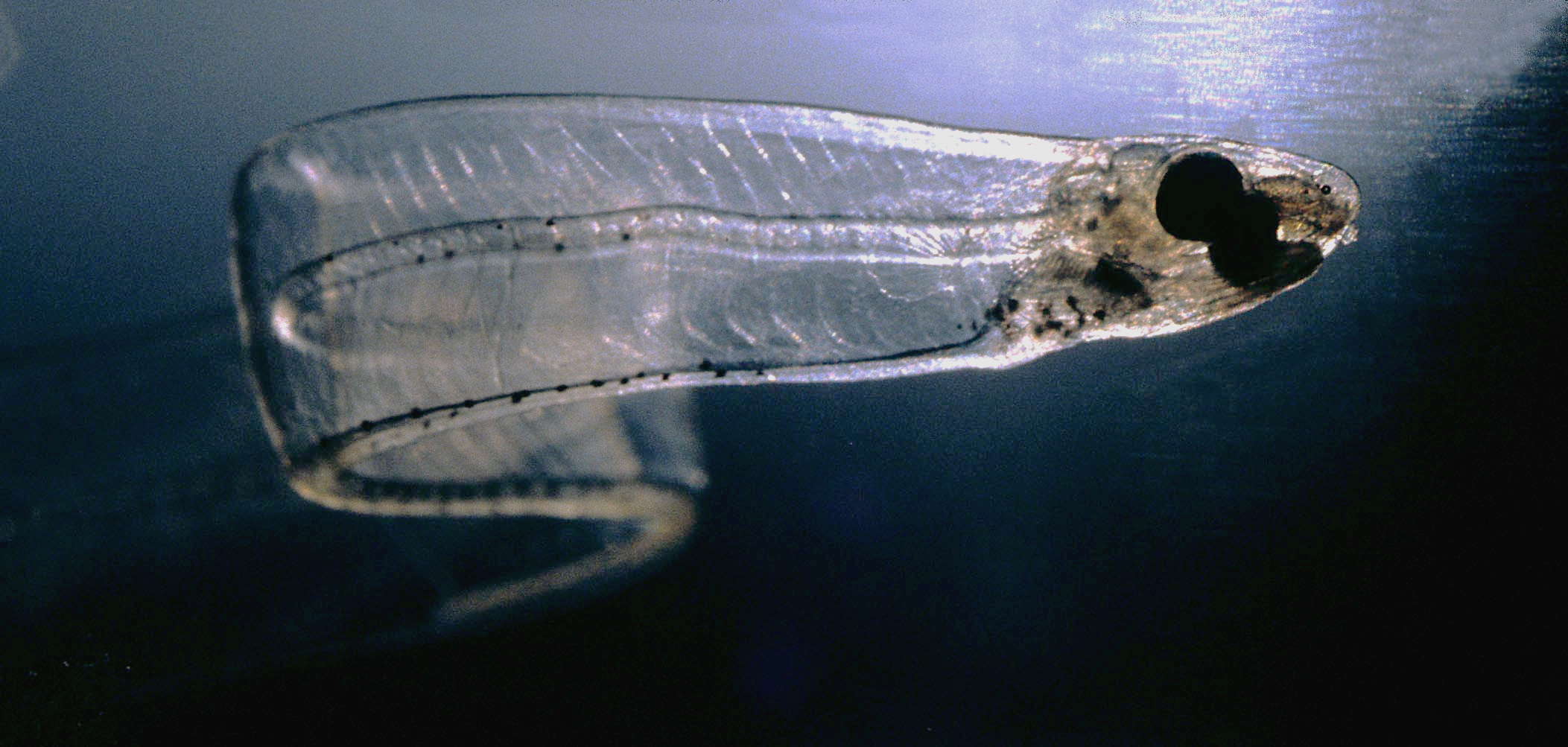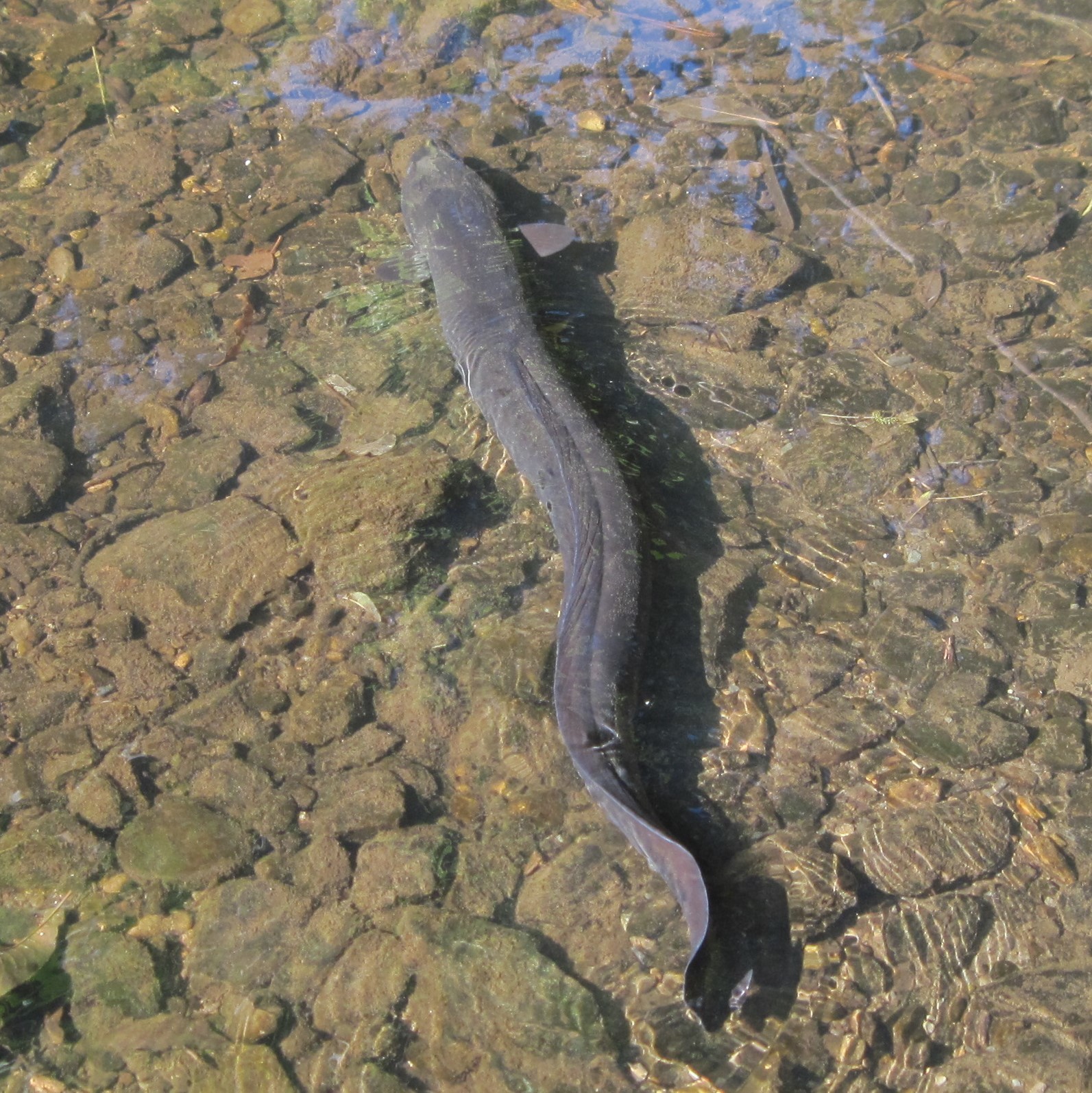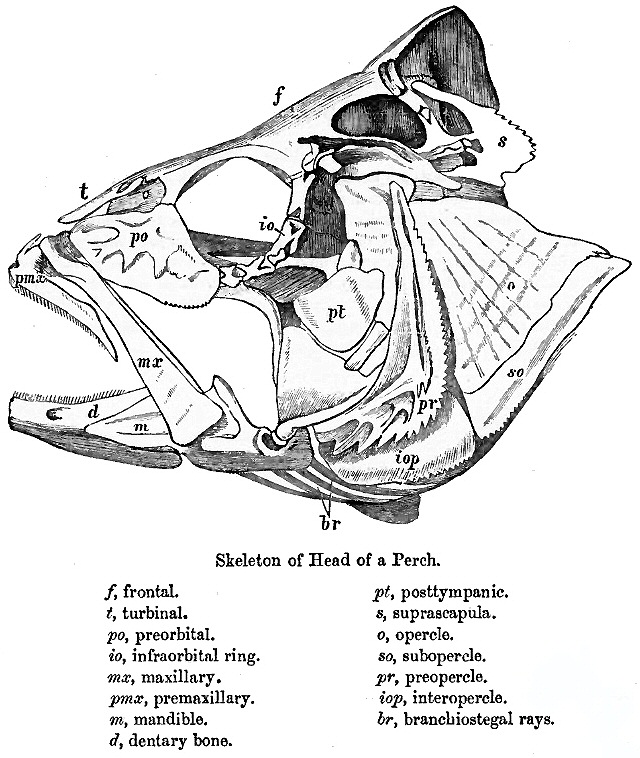|
Leptocephali
A leptocephalus (meaning "slim head") is the flat and transparent larva of eels and other members of the superorder Elopomorpha. This is one of the most diverse groups of teleosts, containing 801 species in 4 orders, 24 families, and 156 genera. This group is thought to have arisen in the Cretaceous period over 140 million years ago.Inuoe, Jun, M. Miya, et al. “Mitogenomic evidence for the monophyly of elopomorph fishes (Teleostei) and the evolutionary origin of the leptocephalus larva.” Molecular Phylogenetics and Evolution 32 (2004): 274-286. Web. 2 Nov. 2012. Fishes with a leptocephalus larval stage include the most familiar eels such as the conger, moray eel, and garden eel as well as members of the family Anguillidae, plus more than 10 other families of lesser-known types of marine eels. These are all true eels of the order Anguilliformes. Leptocephali of eight species of eels from the South Atlantic Ocean were described by Meyer-Rochow The fishes of the other fou ... [...More Info...] [...Related Items...] OR: [Wikipedia] [Google] [Baidu] |
Glass Eel
Eels are any of several long, thin, bony fishes of the order Anguilliformes. They have a catadromous life cycle, that is: at different stages of development migrating between inland waterways and the deep ocean. Because fishermen never caught anything they recognized as young eels, the Biological life cycle, life cycle of the eel was long a mystery. Of particular interest has been the search for the spawning grounds for the various species of eels, and identifying the population impacts of different stages of the life cycle. Past studies of eels The European eel (''Anguilla anguilla'') is the one most familiar to Western scientists, beginning with Aristotle, who wrote the earliest known inquiry into the natural history of eels. He speculated that they were born of "earth worms", which he believed were formed of mud, growing from the "guts of wet soil" rather than through sexual reproduction. Many centuries passed before scientists were able to demonstrate that such spontaneous gene ... [...More Info...] [...Related Items...] OR: [Wikipedia] [Google] [Baidu] |
Pelican Eel
The pelican eel (''Eurypharynx pelecanoides'') is a deep-sea eel. It is the only known member of the genus ''Eurypharynx'' and the family Eurypharyngidae. It belongs to the " saccopharyngiforms", members of which were historically placed in their own order, but are now considered true eels in the order Anguilliformes. The pelican eel has been described by many synonyms, yet nobody has been able to demonstrate that more than one species of pelican eel exists. It is also referred to as the gulper eel (which can also refer to members of the related genus ''Saccopharynx''), pelican gulper, and umbrella-mouth gulper. The specific epithet ''pelecanoides'' refers to the pelican, as the fish's large mouth is reminiscent of that of the pelican. Description The morphology of pelican eel specimens can be hard to describe because they are so fragile that they become damaged when they are recovered from the deep sea's immense pressure. However, certain observations about the physical characte ... [...More Info...] [...Related Items...] OR: [Wikipedia] [Google] [Baidu] |
Anguillidae
The Anguillidae are a family of ray-finned fish that contains the freshwater eels. All the extant species and six subspecies in this family are in the genus ''Anguilla'', and are elongated fish of snake-like bodies, with long dorsal, caudal and anal fins forming a continuous fringe. They are catadromous, spending their adult lives in freshwater, but migrating to the ocean to spawn. Eels are an important food fish and some species are now farm-raised, but not bred in captivity. Many populations in the wild are now threatened, and Seafood Watch recommend consumers avoid eating anguillid eels. Physical description Adult freshwater eels are elongated with tubelike, snake-shaped bodies. They have large, pointed heads and their dorsal fins are usually continuous with their caudal and anal fins, to form a fringe lining the posterior end of their bodies. They have relatively well developed eyes and pectoral fins compared to saltwater eels that they use to navigate and maneuver thro ... [...More Info...] [...Related Items...] OR: [Wikipedia] [Google] [Baidu] |
Anguilliformes
Eels are ray-finned fish belonging to the order (biology), order Anguilliformes (), which consists of eight suborders, 20 Family (biology), families, 164 genus, genera, and about 1000 species. Eels undergo considerable development from the early larval stage to the eventual adult stage and are usually predators. The term "eel" is also used for some other eel-shaped fish, such as electric eels (genus ''Electrophorus''), swamp eels (order Synbranchiformes), and deep-sea spiny eels (family Notacanthidae). However, these other clades, with the exception of deep-sea spiny eels, whose order Notacanthiformes is the sister clade to true eels, convergent evolution, evolved their eel-like shapes independently from the true eels. As a main rule, most eels are marine. Exceptions are the catadromous genus Anguillidae, ''Anguilla'' and the Gymnothorax polyuranodon, freshwater moray, which spend most of their life in freshwater, the Fish migration#Classification, anadromous rice-paddy eel, whi ... [...More Info...] [...Related Items...] OR: [Wikipedia] [Google] [Baidu] |
Anguilla Anguilla
The European eel (''Anguilla anguilla'') is a species of eel. Their life history was a mystery for thousands of years, and mating in the wild has not yet been observed. The five stages of their development were originally thought to be different species. They are critically endangered due to hydroelectric dams, overfishing by fisheries on coasts for human consumption, and parasites. Description European eels undergo five stages of development in their lifecycle: larva ( leptocephalus), glass eel, elver, yellow eel, and silver eel. Adults in the yellow phase are typically around and rarely reach more than , but they can reach a length of up to in exceptional cases. They have 110 to 120 vertebrae. tend to live approximately 15–20 years in the wild, although captive specimens have lived for over 80 years. One such specimen known as "the Brantevik Eel" lived for 155 years in the well of a family home in Brantevik, a fishing village in southern Sweden. Ecology Eels tend ... [...More Info...] [...Related Items...] OR: [Wikipedia] [Google] [Baidu] |
Teleost
Teleostei (; Ancient Greek, Greek ''teleios'' "complete" + ''osteon'' "bone"), members of which are known as teleosts (), is, by far, the largest group of ray-finned fishes (class Actinopterygii), with 96% of all neontology, extant species of fish. The Teleostei, which is variously considered a Division (zoology), division or an infraclass in different taxonomic systems, include over 26,000 species that are arranged in about 40 order (biology), orders and 448 family (biology), families. Teleosts range from giant oarfish measuring or more, and ocean sunfish weighing over , to the minute male anglerfish ''Photocorynus spiniceps'', just long. Including not only torpedo-shaped fish built for speed, teleosts can be flattened vertically or horizontally, be elongated cylinders or take specialised shapes as in anglerfish and seahorses. The difference between teleosts and other bony fish lies mainly in their jaw bones; teleosts have a movable premaxilla and corresponding modifications ... [...More Info...] [...Related Items...] OR: [Wikipedia] [Google] [Baidu] |
Pelvic Fin
Pelvic fins or ventral fins are paired fins located on the ventral (belly) surface of fish, and are the lower of the only two sets of paired fins (the other being the laterally positioned pectoral fins). The pelvic fins are homologous to the hindlimbs of tetrapods, which evolved from lobe-finned fish during the Middle Devonian. Structure and function Structure In actinopterygians, the pelvic fin consists of two endochondrally-derived bony girdles attached to bony radials. Dermal fin rays ( lepidotrichia) are positioned distally from the radials. There are three pairs of muscles each on the dorsal and ventral side of the pelvic fin girdle that abduct and adduct the fin from the body. Pelvic fin structures can be extremely specialized in actinopterygians. Gobiids and lumpsuckers modify their pelvic fins into a sucker disk that allow them to adhere to the substrate or climb structures, such as waterfalls. In priapiumfish, males have modified their pelvic structures into ... [...More Info...] [...Related Items...] OR: [Wikipedia] [Google] [Baidu] |
Red Blood Cell
Red blood cells (RBCs), referred to as erythrocytes (, with -''cyte'' translated as 'cell' in modern usage) in academia and medical publishing, also known as red cells, erythroid cells, and rarely haematids, are the most common type of blood cell and the vertebrate's principal means of delivering oxygen () to the body tissue (biology), tissues—via blood flow through the circulatory system. Erythrocytes take up oxygen in the lungs, or in fish the gills, and release it into tissues while squeezing through the body's capillary, capillaries. The cytoplasm of a red blood cell is rich in hemoglobin (Hb), an iron-containing biomolecule that can bind oxygen and is responsible for the red color of the cells and the blood. Each human red blood cell contains approximately 270 million hemoglobin molecules. The cell membrane is composed of proteins and lipids, and this structure provides properties essential for physiological Cell (biology), cell function such as erythrocyte deformabil ... [...More Info...] [...Related Items...] OR: [Wikipedia] [Google] [Baidu] |
Metamorphose
Metamorphosis is a biological process by which an animal physically developmental biology, develops including birth, birth transformation or hatching, involving a conspicuous and relatively abrupt change in the animal's body structure through cell cell growth#Cell division, growth and cellular differentiation, differentiation. Some insects, jellyfish, fish, amphibians, mollusks, crustaceans, cnidarians, echinoderms, and tunicates undergo metamorphosis, which is often accompanied by a change of nutrition source or behavior. Animals can be divided into species that undergo complete metamorphosis ("Holometabolism, holometaboly"), incomplete metamorphosis ("Hemimetabolism, hemimetaboly"), or no metamorphosis ("Ametabolism, ametaboly"). Generally organisms with a larval stage undergo metamorphosis, and during metamorphosis the organism loses larval characteristics. Etymology The word ''metamorphosis'' derives from Ancient Greek language, Ancient Greek , "transformation, transform ... [...More Info...] [...Related Items...] OR: [Wikipedia] [Google] [Baidu] |
Fish Larvae
Ichthyoplankton (from Greek: wikt:ἰχθύς, ἰχθύς, , "fish"; and πλαγκτός, , "drifter") are the Fish eggs, eggs and larvae of fish. They are mostly found in the sunlit zone of the water column, less than 200 metres deep, which is sometimes called the epipelagic or photic zone. Ichthyoplankton are planktonic, meaning they cannot swim effectively under their own power, but must drift with the ocean currents. Fish eggs cannot swim at all, and are unambiguously planktonic. Early stage larvae swim poorly, but later stage larvae swim better and cease to be planktonic as they grow into Juvenile fish, juveniles. Fish larvae are part of the zooplankton that eat smaller plankton, while fish eggs carry their own food supply. Both eggs and larvae are themselves eaten by larger animals. Fish can produce high numbers of eggs which are often released into the open water column. Fish eggs typically have a diameter of about . The newly hatched young of oviparous fish are called ... [...More Info...] [...Related Items...] OR: [Wikipedia] [Google] [Baidu] |








